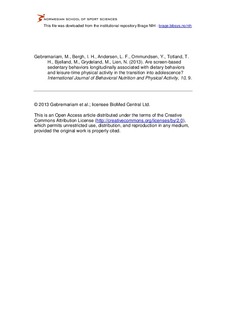| dc.contributor.author | Gebremariam, Mekdes K. | |
| dc.contributor.author | Bergh, Ingunn Holden | |
| dc.contributor.author | Andersen, Lene F. | |
| dc.contributor.author | Ommundsen, Yngvar | |
| dc.contributor.author | Totland, Torunn Holm | |
| dc.contributor.author | Bjelland, Mona | |
| dc.contributor.author | Grydeland, May | |
| dc.contributor.author | Lien, Nanna | |
| dc.date.accessioned | 2013-05-23T10:59:32Z | |
| dc.date.available | 2013-05-23T10:59:32Z | |
| dc.date.issued | 2013-01-25 | |
| dc.identifier | Seksjon for coaching og psykologi / Department of Coaching and Psychology | |
| dc.identifier.citation | International Journal of Behavioral Nutrition and Physical Activity. 2013, 10, 9 | no_NO |
| dc.identifier.issn | 1479-5868 | |
| dc.identifier.uri | http://hdl.handle.net/11250/171112 | |
| dc.description | © 2013 Gebremariam et al.; licensee BioMed Central Ltd. This is an Open Access article distributed under the terms of the Creative Commons Attribution License, which permits unrestricted use, distribution, and reproduction in any medium, provided the original work is properly cited. | no_NO |
| dc.description.abstract | Background: There is a need for more longitudinal studies investigating the associations between screen-based sedentary behaviors (SB), dietary behaviors and leisure-time physical activity (PA).
Methods: In the HEIA cohort study, 908 children were followed from age 11 to age 13 (September 2007 – May 2009). The children self-reported their intake of fruits, vegetables, soft drinks with sugar and snacks. TV/DVD use, computer/game use and leisure-time PA were also self-reported. Multilevel generalized linear mixed model analysis was used to assess longitudinal associations between the screen-based SB and each of the two other behaviors.
Results: Twenty-month changes in TV/DVD use and computer/game use were positively associated with changes in the consumption of soft drinks with sugar and unhealthy snacks in the same period; and inversely associated with change in vegetable consumption. Change in computer/game use was also inversely related to change in fruit consumption. An inverse but non-substantive association was found between change in TV/DVD use and change in leisure-time PA. Change in computer/game use was not significantly associated with change in leisure-time PA.
Conclusions: Changes in screen-based SB were associated with multiple unfavorable changes in dietary habits, although the associations were weak. These associations need to be further investigated in intervention/experimental studies, to assess whether changing screen-based SB will result in clinically relevant changes in dietary behaviors. However, the findings of this study suggest that screen-based SB and leisure-time PA are largely independent behaviors which should be addressed separately in health promotion activities. | no_NO |
| dc.language.iso | eng | no_NO |
| dc.publisher | BioMed Central | no_NO |
| dc.subject | children | no_NO |
| dc.subject | adolescents | no_NO |
| dc.subject | sedentary behaviors | no_NO |
| dc.subject | screen time | no_NO |
| dc.subject | dietary behaviors | no_NO |
| dc.subject | physical activity | no_NO |
| dc.subject | associations | no_NO |
| dc.subject | longitudinal | no_NO |
| dc.title | Are screen-based sedentary behaviors longitudinally associated with dietary behaviors and leisure-time physical activity in the transition into adolescence? | no_NO |
| dc.type | Journal article | no_NO |
| dc.type | Peer reviewed | no_NO |
| dc.subject.nsi | VDP::Social science: 200::Social science in sports: 330 | no_NO |
| dc.subject.nsi | VDP::Medical disciplines: 700::Sports medicine: 850 | no_NO |
| dc.source.journal | International Journal of Behavioral Nutrition and Physical Activity | |
| dc.identifier.doi | 10.1186/1479-5868-10-9 | |
